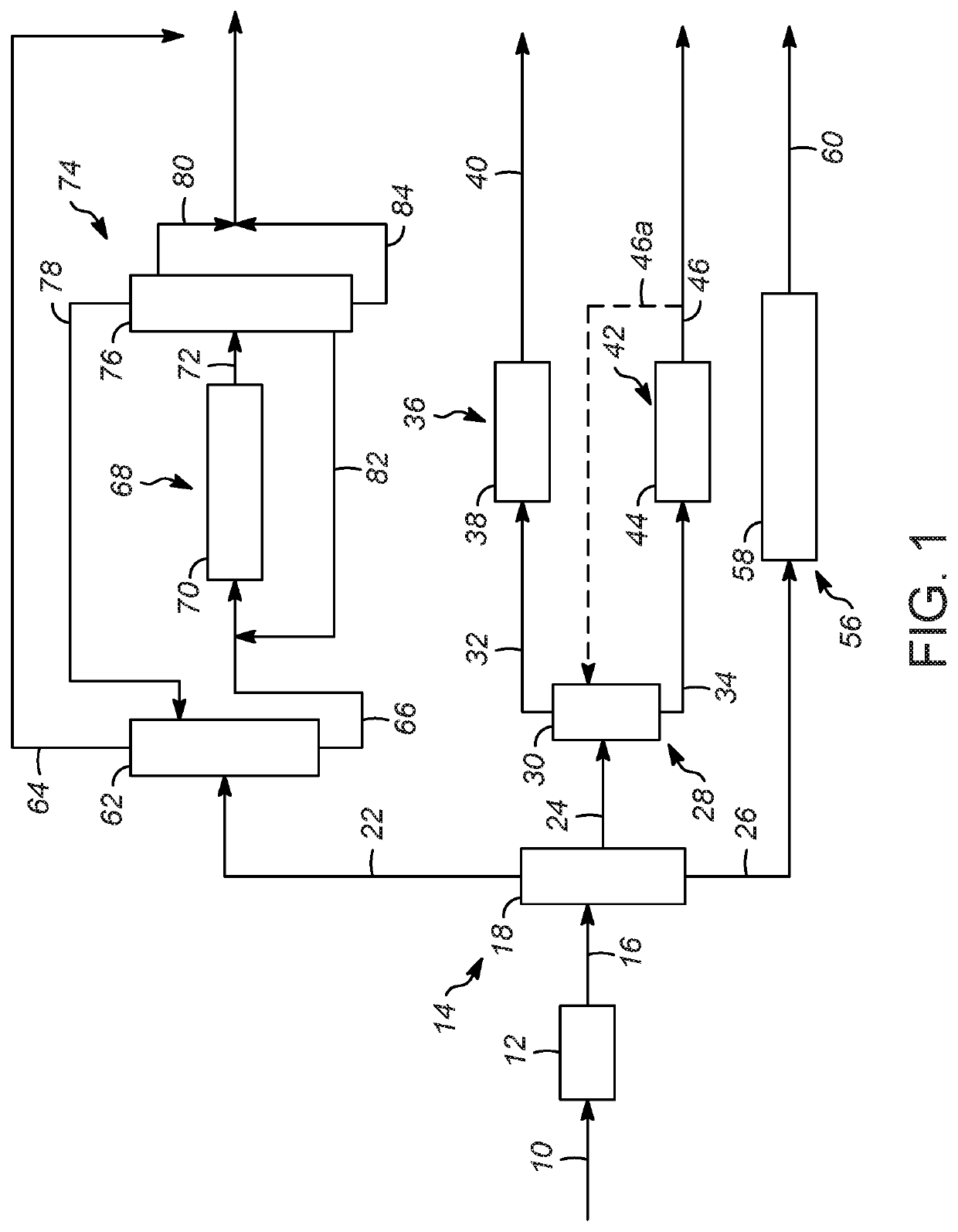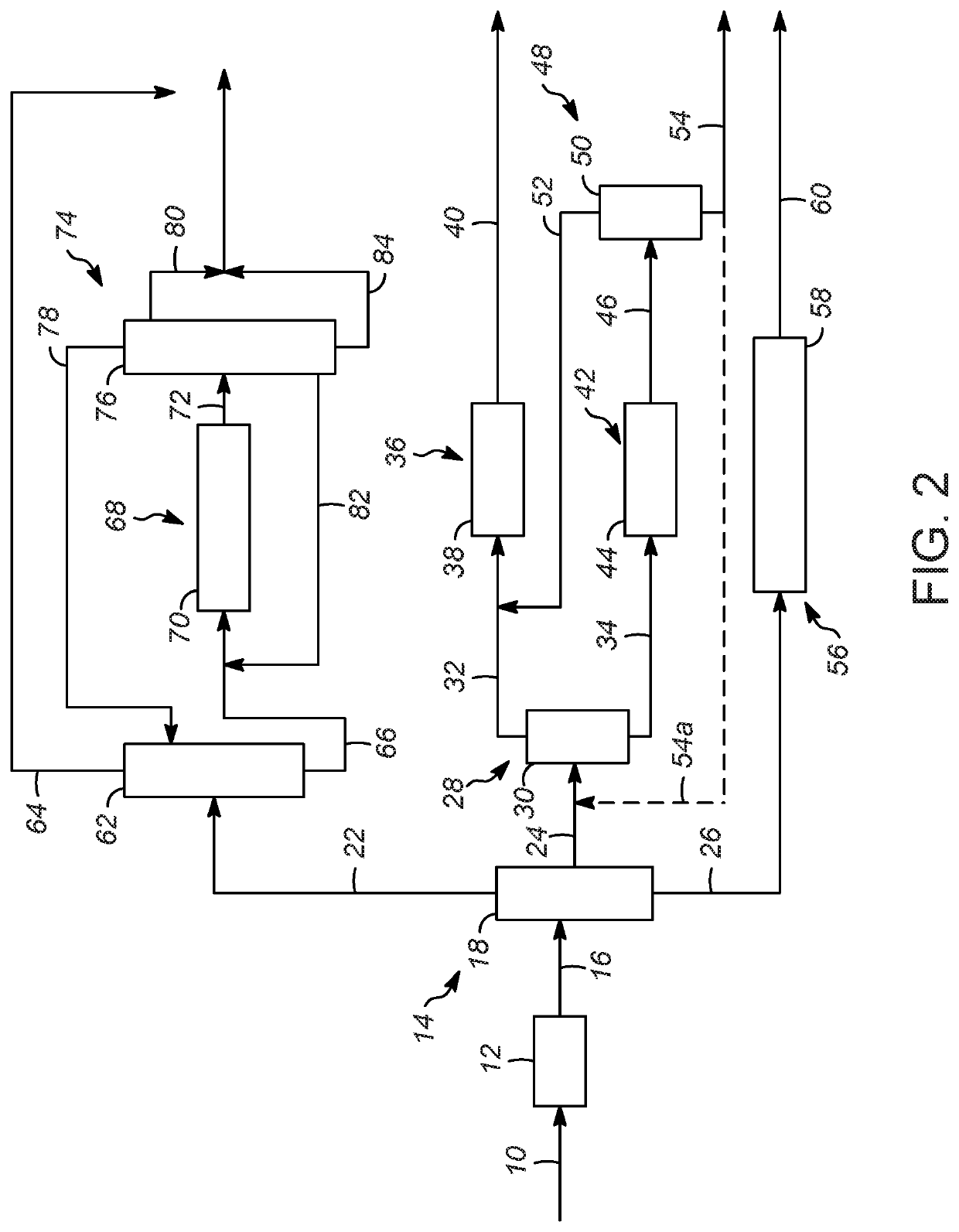Processes for increasing an octane value of a gasoline component
a technology of octane value and gasoline, which is applied in the direction of hydrocarbon oil treatment, hydrocarbon oil treatment, naphtha reforming, etc., can solve the problems of reducing the profitability of refiners, difficult to meet aromatics specifications, and stricter gasoline specifications for refiners, so as to reduce the amount of lower value heavy naphtha, facilitate production, and process feed streams efficiently and effectively
- Summary
- Abstract
- Description
- Claims
- Application Information
AI Technical Summary
Benefits of technology
Problems solved by technology
Method used
Image
Examples
example 1
[0065]When nC7 is dehydrogenated to the corresponding normal C7 mono-olefins, the octane numbers range between 54.5 to 90.2 RON with an average of 77.0 RON as listed in Table 1, below. When a single-branched iC7 paraffin such as 3-methylhexane for example is dehydrogenated to the corresponding iC7 mono-olefins, the octane numbers range between 82.2 to 98.6 RON with an average of 92.5 RON. When multi-branched iC7 paraffins such as 2,2-dimethylpentane, 2,4-deimethylpentane and 3,3-deimethylpentane for example are dehydrogenated to the corresponding multi-branched iC7 mono-olefins, the octane numbers range from 99.2 to 105.3 RON with averages of 100.2-103.1 RON as shown in Table 1. Therefore, in terms of octane increase, it is more advantageous to dehydrogenate single-branched iC7 paraffins as compared to nC7 and it is most advantageous to dehydrogenate multi-branched iC7 paraffins which have the highest mono-olefin octanes.
[0066]
TABLE 1Pure component octanes (RON) for C7 hydrocarbons....
example 2
[0067]Table 2, below, shows that it is important to fractionate as much of the cyclohexane and benzene from the front end of the iC7 stream that is sent the dehydrogenation zone to prevent cyclohexane from dehydrogenating to form benzene. It is evident that some multi-branched iC7 paraffins co-boil with cyclohexane and will be excluded. The iC7 stream will contain some multi-branched iC7 paraffins but will be rich in single-branched iC7 paraffins. Table 2 also shows that nC7 and MCH have relatively close boiling points and above the iC7 paraffins, therefore a nC7+MCH stream can be fractionated. To obtain the desired cuts, it is envisioned that additional trays can be added to the fractionation columns, or a divided wall can be utilized inside the columns or other known techniques to improve the fractionation between the C7 species can be utilized.
[0068]
TABLE 2Normal boiling points from the API Databook.CarbonAPI NormalBoiling NumberPoints, ° C. (° F.)Hydrocarbon Component6 80.7 (177...
example 3
[0069]From pilot plant data, a dehydrogenation model was formulated and placed into a process simulator to estimate the temperature drop over a single dehydrogenation reactor and the products formed. The process conditions of the dehydrogenation reactor (layered catalyst with the outer layer comprising gamma alumina with dispersed metals Pt, Sn, and Li) were set to 565° C. (1049° F.) inlet temperature, 137.9 kPa (20 psig), 10 h−1 LHSV, and hydrogen / hydrocarbon mole ratio of three. A dehydrogenation feed that was MCH-free was selected to demonstrate the effect of allowing MCH into the dehydrogenation reactor. The MCH-free feed consisted of 11.7 wt % n-heptane, 21.3 wt % 2-methylhexane, 19.9 wt % 3-methylhexane, 1.6 wt % 3-ethylpentane, 34.3 wt % multi-branched C7 isoparaffins, and 11.2 wt % C7 cyclopentanes.
[0070]Table 3, below, shows the results of the process simulations for the MCH-free feed and the feeds that contained increasing amounts of MCH. For the MCH-free feed, the highest...
PUM
| Property | Measurement | Unit |
|---|---|---|
| research octane number | aaaaa | aaaaa |
| temperature | aaaaa | aaaaa |
| diameter | aaaaa | aaaaa |
Abstract
Description
Claims
Application Information
 Login to View More
Login to View More - R&D
- Intellectual Property
- Life Sciences
- Materials
- Tech Scout
- Unparalleled Data Quality
- Higher Quality Content
- 60% Fewer Hallucinations
Browse by: Latest US Patents, China's latest patents, Technical Efficacy Thesaurus, Application Domain, Technology Topic, Popular Technical Reports.
© 2025 PatSnap. All rights reserved.Legal|Privacy policy|Modern Slavery Act Transparency Statement|Sitemap|About US| Contact US: help@patsnap.com



